We all know that magnification increases if we stack two or more close-up lenses together. The same holds true if we stack two teleconverter lenses. In general, if one converter has power A and the other has power B, stacking them together would yield a teleconverter of power A×B. For example, the Sony VCL HGD1758 and Olympus TCON-14B have powers 1.7X and 1.45X, respectively. If we can find some way to stack them together, the resulting lens will have a power of 2.465X = 1.7×1.45.
But, what is "stacking lenses" anyway. Actually, it is very simple. We just connect a number of teleconverters together. Because the combo has a higher power, it extends the focal length of the camera lens. The following shows an extreme example: a Sonly VCL HGD1758, an Olympus TCON-14B and a Nikon TC-E15ED 1.5X teleconverters are connected together, forming a "new" teleconverter with a power of about 3.7X = 1.7×1.45×1.5. This combo is mounted on a FZ-30, and extends the longest focal length of the FZ-30 from 420mm to 1553mm!
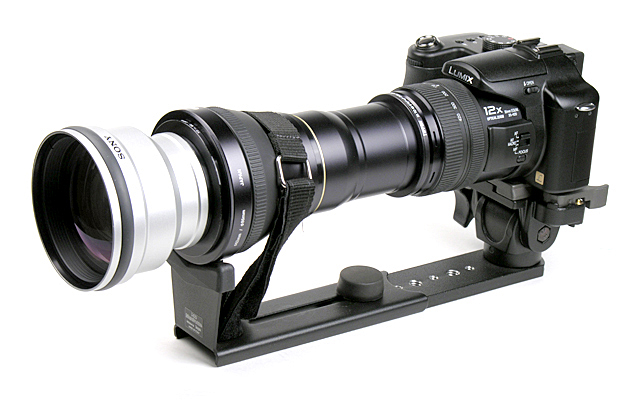
|
However, stacking teleconverter lenses does have some drawbacks.
Given the above reasons, unless you can live with a lower image quality, can find two good teleconverter lenses and mounting mechanism that will not cause vignetting, and do not mind the weight and size, you perhaps would not go into this stacking teleconverter lenses direction.
To illustrate the above points, two very good teleconverter lenses are used: the Sony VCL HGD1758 and Olympus TCON-14B. Click here for more information about these two lenses. The Sony VCL HGD1758 does not have a front thread, and the TCON-14B has a 86mm front thread. This prevents us from putting the TCON-14B in front of the higher power Sony VCL HGD1758. I managed to find a 86-77mm step-down ring. Therefore, a 86-77mm step-down ring, a 77-72mm step-down ring and a 72-58mm step-down ring are used to mount the Sony VCL HGD1758 in front of the TCON-14B. Of course, the use of three step rings is not very promising because they push the Sony VCL HGD1758 away from the Olympus TCON-14B. However, this is the only choice I have. The left image below shows the huge combo, and the combined power is 2.465X = 1.7×1.45. Since the Minolta ACT-100 1.5X also has a 86mm front thread, it can be used with the Sony VCL HGD1758 as well. The right image below shows this combo with a combined power of 2.55X = 1.7×1.5. Since TCON-14B has a better center resolution than the Minolta ACT-100, I chose the TCON-14B for this test.
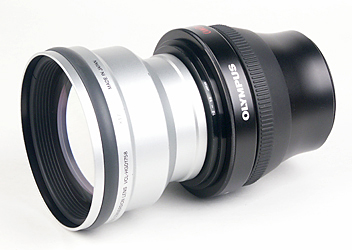
|
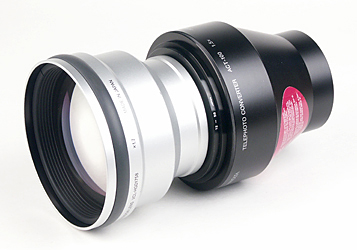
|
| Sony VCL HGD1758 and Olympus TCON-14B | Sony VCL HGD1758 and Minolta ACT-100 1.5X |
With this combo mounted on a FZ-30, since its power is 2.465X, the longest combined focal length of a FZ-30 is 1035.3mm = 2.465×420!
With this combo mounted on a FZ-30, it is huge and longer and heavier than the Panasonic DMW-LTZ10 teleconverter lens. The left image below shows this combo mounted on a FZ-30. Since this is a huge and heavy combo, a lens support is needed so that the combo and the camera can be settled on a tripod in a balanced way. The right image below shows the combo mounted on a Bogen/Manfrotto 3420 Telephoto Lens Support. This is the only lens support of good quality I can find.
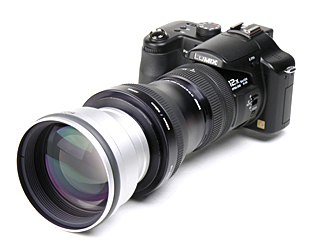
|
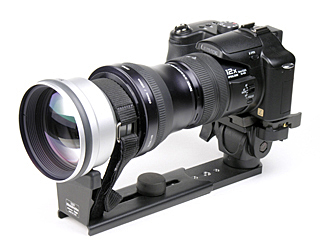
|
This Sony VCL HGD1758 and Olympus TCON-14B does not cause vignetting at the 420mm maximum focal length; however, light fall-off at the corners is obvious if it is used to shoot uniformly colored scene as shown below. In general shooting, this light fall-off is not very obvious.

To see how good the resolution of this combo is, I framed a tree trunk at the center and took a shot. Then, use the same focusing area but move the tree trunk to about 3/4 of the frame and take a second shot. Finally, repeat the same process but move the tree trunk to the right edge. Thus, in all images the tree trunk should be very sharp even though its position may be different due to different composition. The reason that the lens is always focused at the center and recompose is simple: we want to ensure that the tree trunk portion is always sharply focused, and, as a result, we would be able to know the image quality reduction when the sharply focused subject is moved to the edge of the image. In the images below, each row has two images, the left one showing the composition and the second being the 100% crop from the yellow frame. Click on the left image to obtain the original full size unprocessed image. Note that The images used ISO 80 and LOW for CONTRAST, SATURATION and SHARPNESS.
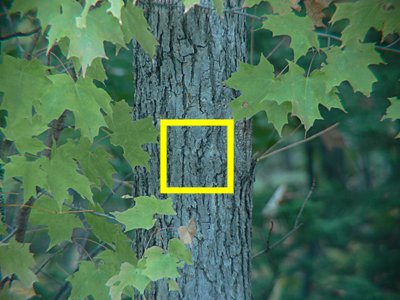
|

|
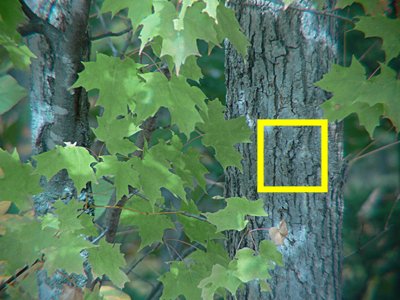
|
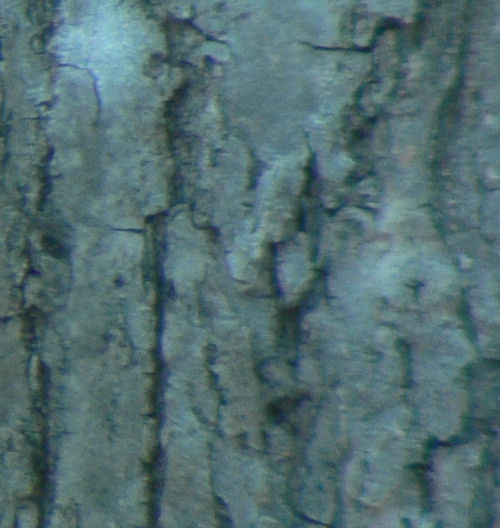
|
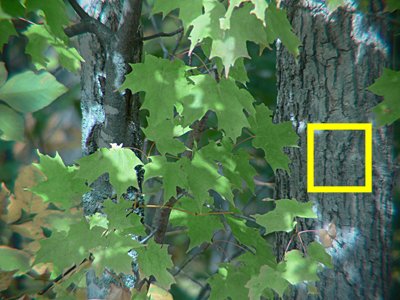
|
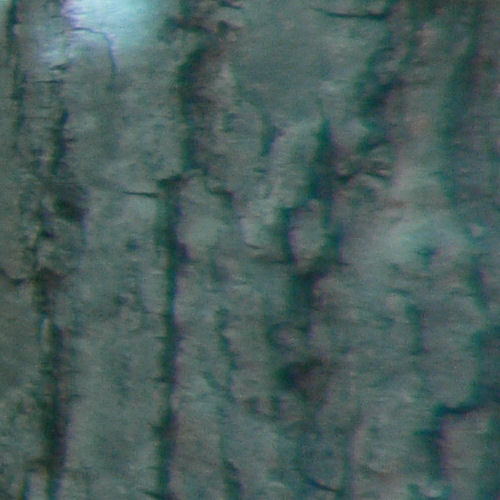
|
| Click on the image to see a full size version | |
Not much chromatic aberration in the form purple fringes is shown in the above images, because I tried to avoid high contrast areas to minimize its impact. However, if the scene contrast is high, purple fringes will occur along high contrast areas. In fact, a touch of purple/blue can be seen in the above images, which may be due to the subject being in shade (i.e., white balance problem) and chromatic aberration. Note that contrast is also lower for off-center subjects.
The above images show the sharpness difference at the center and edge. In summary, if you wish to have some fun, stacking two or more teleconverters would definitely be interesting. However, the results may not be as good as you expected. In general, the sharpness is only good at the center small area, and contrast and resolution power are usually lower than expected. If your work can sustain a significant crop and/or you only use the images in small size, stacking teleconverter lenses may still have some good values. On the other hand, if you really need lens power larger than 2.0X, consider the use of one teleconverter (e.g., Raynox 2020PRO 2.2X) first because it may provide you with better results than stacking two not-so-good teleconverters. Note that the loss of image quality may not be obvious with small size images.
The following has some random testing shots. Most of them were cropped and slightly leveled.
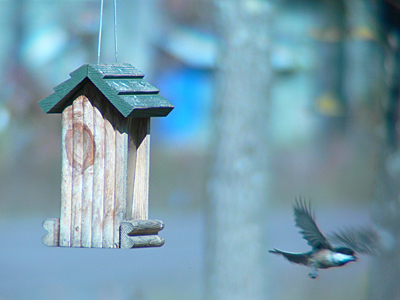
|
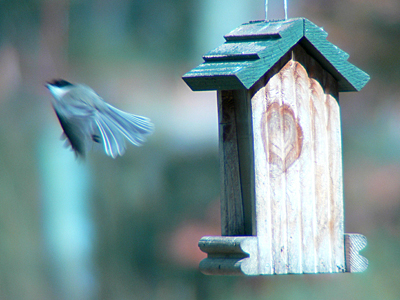
|
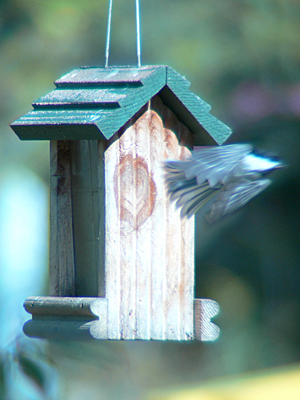
|
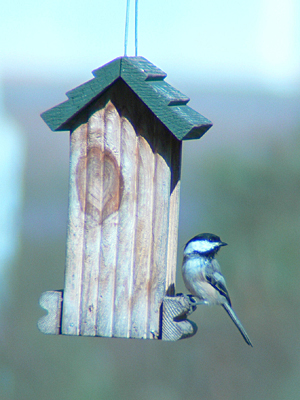
|
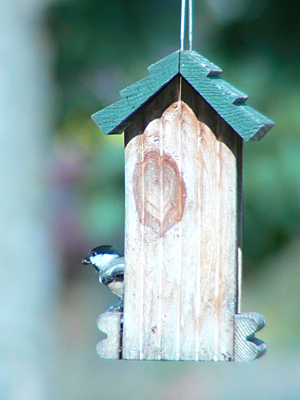
|